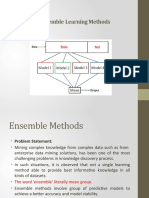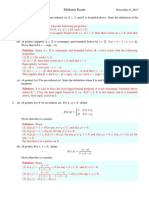Scipy Cheat Sheet Python For Data Science: Linear Algebra
Uploaded by
Lourdes Victoria UrrutiaScipy Cheat Sheet Python For Data Science: Linear Algebra
Uploaded by
Lourdes Victoria Urrutia> Linear Algebra Also see NumPy
Python For Data Science
You’ll use the linalg and sparse modules.
Note that scipy.linalg contains and expands on numpy.linalg.
Matrix Functions
SciPy Cheat Sheet
Addition
>>> from scipy import linalg, sparse
>>> np.add(A,D) #Addition
Creating Matrices Subtraction
Learn SciPy online at www.DataCamp.com >>> np.subtract(A,D) #Subtraction
>>> A = np.matrix(np.random.random((2,2)))
Division
>>> B = np.asmatrix(b)
>>> np.divide(A,D) #Division
>>> C = np.mat(np.random.random((10,5)))
>>> D = np.mat([[3,4], [5,6]]) Multiplication
>>> np.multiply(D,A) #Multiplication
SciPy Basic Matrix Routines
>>>
>>>
>>>
np.dot(A,D) #Dot product
np.vdot(A,D) #Vector dot product
np.inner(A,D) #Inner product
Inverse >>> np.outer(A,D) #Outer product
The SciPy library is one of the core packages for
>>> np.tensordot(A,D) #Tensor dot product
>>> A.I #Inverse
>>> np.kron(A,D) #Kronecker product
scientific computing that provides mathematical
>>> linalg.inv(A) #Inverse
algorithms and convenience functions built on the
>>> A.T #Tranpose matrix
Exponential Functions
>>> A.H #Conjugate transposition
>>> linalg.expm(A) #Matrix exponential
NumPy extension of Python. >>> np.trace(A) #Trace >>> linalg.expm2(A) #Matrix exponential (Taylor Series)
Norm >>> linalg.expm3(D) #Matrix exponential (eigenvalue decomposition)
>>> linalg.norm(A) #Frobenius norm
Logarithm Function
> Interacting With NumPy Also see NumPy >>> linalg.norm(A,1) #L1 norm (max column sum)
>>> linalg.norm(A,np.inf) #L inf norm (max row sum)
>>> linalg.logm(A) #Matrix logarithm
Trigonometric Functions
Rank >>> linalg.sinm(D) Matrix sine
>>> import numpy as np
>>> a = np.array([1,2,3])
>>> np.linalg.matrix_rank(C) #Matrix rank >>> linalg.cosm(D) Matrix cosine
>>> b = np.array([(1+5j,2j,3j), (4j,5j,6j)])
>>> linalg.tanm(A) Matrix tangent
Determinant
>>> c = np.array([[(1.5,2,3), (4,5,6)], [(3,2,1), (4,5,6)]]) Hyperbolic Trigonometric Functions
>>> linalg.det(A) #Determinant
>>> linalg.sinhm(D) #Hypberbolic matrix sine
Solving linear problems
Index Tricks >>> linalg.solve(A,b) #Solver for dense matrices
>>> linalg.coshm(D) #Hyperbolic matrix cosine
>>> linalg.tanhm(A) #Hyperbolic matrix tangent
>>> E = np.mat(a).T #Solver for dense matrices
>>> np.mgrid[0:5,0:5] #Create a dense meshgrid
>>> linalg.lstsq(D,E) #Least-squares solution to linear matrix equation Matrix Sign Function
>>> np.ogrid[0:2,0:2] #Create an open meshgrid
>>> np.sigm(A) #Matrix sign function
>>> np.r_[[3,[0]*5,-1:1:10j] #Stack arrays vertically (row-wise)
Generalized inverse
>>> np.c_[b,c] #Create stacked column-wise arrays >>> linalg.pinv(C) #Compute the pseudo-inverse of a matrix (least-squares solver)
Matrix Square Root
>>> linalg.pinv2(C) #Compute the pseudo-inverse of a matrix (SVD) >>> linalg.sqrtm(A) #Matrix square root
Shape Manipulation Arbitrary Functions
Creating Sparse Matrices >>> linalg.funm(A, lambda x: x*x) #Evaluate matrix function
>>> np.transpose(b) #Permute array dimensions
>>>
>>>
b.flatten() #Flatten the array
np.hstack((b,c)) #Stack arrays horizontally (column-wise)
>>>
>>>
F = np.eye(3, k=1) #Create a 2X2 identity matrix
G = np.mat(np.identity(2)) #Create a 2x2 identity matrix
Decompositions
>>> np.vstack((a,b)) #Stack arrays vertically (row-wise)
>>> C[C > 0.5] = 0
>>> np.hsplit(c,2) #Split the array horizontally at the 2nd index
>>> H = sparse.csr_matrix(C) #Compressed Sparse Row matrix
Eigenvalues and Eigenvectors
>>> np.vpslit(d,2) #Split the array vertically at the 2nd index >>> I = sparse.csc_matrix(D) #Compressed Sparse Column matrix
>>> la, v = linalg.eig(A) #Solve ordinary or generalized eigenvalue problem for square matrix
>>> J = sparse.dok_matrix(A) #Dictionary Of Keys matrix
>>> l1, l2 = la #Unpack eigenvalues
>>> E.todense() #Sparse matrix to full matrix
Polynomials >>> sparse.isspmatrix_csc(A) #Identify sparse matrix
>>>
>>>
v[:,0] #First eigenvector
v[:,1] #Second eigenvector
>>> linalg.eigvals(A) #Unpack eigenvalues
>>> from numpy import poly1d
>>> p = poly1d([3,4,5]) #Create a polynomial object Sparse Matrix Routines Singular Value Decomposition
>>> U,s,Vh = linalg.svd(B) #Singular Value Decomposition (SVD)
Inverse >>> M,N = B.shape
Vectorizing Functions >>> sparse.linalg.inv(I) #Inverse >>> Sig = linalg.diagsvd(s,M,N) #Construct sigma matrix in SVD
Norm LU Decomposition
>>> def myfunc(a): if a < 0:
>>> P,L,U = linalg.lu(C) #LU Decomposition
return a*2
>>> sparse.linalg.norm(I) #Norm
else:
Solving linear problems
return a/2
>>> sparse.linalg.spsolve(H,I) #Solver for sparse matrices
>>> np.vectorize(myfunc) #Vectorize functions
Type Handling Sparse Matrix Functions
>>> sparse.linalg.expm(I) #Sparse matrix exponential
>>> np.real(c) #Return the real part of the array elements
>>> np.imag(c) #Return the imaginary part of the array elements
>>>
>>>
np.real_if_close(c,tol=1000) #Return a real array if complex parts close to 0
np.cast['f'](np.pi) #Cast object to a data type Sparse Matrix Decompositions
>>> la, v = sparse.linalg.eigs(F,1) #Eigenvalues and eigenvectors
Other Useful Functions >>> sparse.linalg.svds(H, 2) #SVD
>>> np.angle(b,deg=True) #Return the angle of the complex argument
>>>
>>>
g = np.linspace(0,np.pi,num=5) #Create an array of evenly spaced values(number of samples)
g [3:] += np.pi
> Asking For Help Learn Data Skills Online at
>>>
>>>
np.unwrap(g) #Unwrap
np.logspace(0,10,3) #Create an array of evenly spaced values (log scale)
www.DataCamp.com
>>> np.select([c<4],[c*2]) #Return values from a list of arrays depending on
conditions
>>> help(scipy.linalg.diagsvd)
>>> misc.factorial(a) #Factorial
>>> np.info(np.matrix)
>>> misc.comb(10,3,exact=True) #Combine N things taken at k time
>>> misc.central_diff_weights(3) #Weights for Np-point central derivative
>>> misc.derivative(myfunc,1.0) #Find the n-th derivative of a function at a point
You might also like
- Lingua Latina Per Se Illustrat - Ørberg, Hans H._8297100% (1)Lingua Latina Per Se Illustrat - Ørberg, Hans H._8297429 pages
- A Handbook of Market Mix Model - Complete V1100% (1)A Handbook of Market Mix Model - Complete V146 pages
- ATAR Mathematics Methods Units 3 & 4: Exam Notes For Western Australian Year 12 StudentsNo ratings yetATAR Mathematics Methods Units 3 & 4: Exam Notes For Western Australian Year 12 Students6 pages
- Solutions Manual Using R Introductory STNo ratings yetSolutions Manual Using R Introductory ST33 pages
- Recent Advances in Artificial IntelligenceNo ratings yetRecent Advances in Artificial Intelligence6 pages
- Deployment: Cheat Sheet: Machine Learning With KNIME Analytics PlatformNo ratings yetDeployment: Cheat Sheet: Machine Learning With KNIME Analytics Platform1 page
- Linear Regression: What Is Regression Analysis?100% (1)Linear Regression: What Is Regression Analysis?21 pages
- Introductory Concepts of Probabability & StatisticsNo ratings yetIntroductory Concepts of Probabability & Statistics6 pages
- Foundations of Calculus For Data Science An Foundational Guide To PDFNo ratings yetFoundations of Calculus For Data Science An Foundational Guide To PDF216 pages
- Hyperparameter Tuning in XGBoost Using Genetic Algorithm100% (1)Hyperparameter Tuning in XGBoost Using Genetic Algorithm11 pages
- CSE-Machine Learning & Big Data - WSS Source BookNo ratings yetCSE-Machine Learning & Big Data - WSS Source Book181 pages
- (Treading On Python 2) Matt Harrison - Treading On Python Volume 2 - Intermediate Python 2 (2013, Hairysun)No ratings yet(Treading On Python 2) Matt Harrison - Treading On Python Volume 2 - Intermediate Python 2 (2013, Hairysun)144 pages
- Python Data Visualization: 2019 Tools and TrendsNo ratings yetPython Data Visualization: 2019 Tools and Trends22 pages
- A Practical Approach To Linear Regression in Machine Learning - by Ashwin Raj - Towards Data ScienceNo ratings yetA Practical Approach To Linear Regression in Machine Learning - by Ashwin Raj - Towards Data Science20 pages
- Chapter# 14 Database Design Theory and NormalizationNo ratings yetChapter# 14 Database Design Theory and Normalization54 pages
- Data Scientist Certification Study GuideNo ratings yetData Scientist Certification Study Guide7 pages
- Minor Project Ii Report Text Mining: Reuters-21578: Submitted by100% (1)Minor Project Ii Report Text Mining: Reuters-21578: Submitted by51 pages
- Probabilistic Reasoning in Artificial IntelligenceNo ratings yetProbabilistic Reasoning in Artificial Intelligence7 pages
- Data Science With R Text Mining by Graham WilliamsNo ratings yetData Science With R Text Mining by Graham Williams21 pages
- We Are Intechopen, The World'S Leading Publisher of Open Access Books Built by Scientists, For ScientistsNo ratings yetWe Are Intechopen, The World'S Leading Publisher of Open Access Books Built by Scientists, For Scientists19 pages
- Creating A Live World Weather Map Using Shiny - by M. Makkawi - The Startup - MediumNo ratings yetCreating A Live World Weather Map Using Shiny - by M. Makkawi - The Startup - Medium40 pages
- ENG 202: Computers and Engineering Object Oriented Programming in PYTHONNo ratings yetENG 202: Computers and Engineering Object Oriented Programming in PYTHON56 pages
- 1 - Interactive Data Visualization With BokehNo ratings yet1 - Interactive Data Visualization With Bokeh31 pages
- 02 The Manga Guideto Databases What Isa Relational DatabaseNo ratings yet02 The Manga Guideto Databases What Isa Relational Database28 pages
- KDnuggets The Complete Collection of Data Science CheatsheetsNo ratings yetKDnuggets The Complete Collection of Data Science Cheatsheets17 pages
- Scipy Cheat Sheet Python For Data Science: Linear AlgebraNo ratings yetScipy Cheat Sheet Python For Data Science: Linear Algebra1 page
- Python SciPy Cheat Sheet Linear Algebra PDFNo ratings yetPython SciPy Cheat Sheet Linear Algebra PDF1 page
- Scikit-Learn Cheat Sheet Python For Data Science: Preprocessing The Data Evaluate Your Model's Performance100% (1)Scikit-Learn Cheat Sheet Python For Data Science: Preprocessing The Data Evaluate Your Model's Performance1 page
- STAT 0202 Outlier Syllabus - Spring 2020 - Regular Term (14-Wk) - 12-2No ratings yetSTAT 0202 Outlier Syllabus - Spring 2020 - Regular Term (14-Wk) - 12-27 pages
- Numpy Cheat Sheet Python For Data Science: Inspecting Your Array Sorting ArraysNo ratings yetNumpy Cheat Sheet Python For Data Science: Inspecting Your Array Sorting Arrays1 page
- 7Rrd D 0Ht D 7Hkrh HR DKH LRU O RU 0 HDHG HH HD 5Rgd D R OO ULR HL DDH HR 7Hhh Rru L RU Hdkh7Dhd DNo ratings yet7Rrd D 0Ht D 7Hkrh HR DKH LRU O RU 0 HDHG HH HD 5Rgd D R OO ULR HL DDH HR 7Hhh Rru L RU Hdkh7Dhd D112 pages
- Share Online Revision: Pure Mathematics 6042/1No ratings yetShare Online Revision: Pure Mathematics 6042/18 pages
- International Journal of Mathematics and Statistics Invention (IJMSI)No ratings yetInternational Journal of Mathematics and Statistics Invention (IJMSI)7 pages
- Wave Propagation in Even and Odd Dimensional SpacesNo ratings yetWave Propagation in Even and Odd Dimensional Spaces5 pages
- A Brief Introduction To Laplace Transformation - As Applied in Vibrations INo ratings yetA Brief Introduction To Laplace Transformation - As Applied in Vibrations I9 pages
- 9709 May June 2011 All Question Papers 1No ratings yet9709 May June 2011 All Question Papers 184 pages
- Advanced Engineering Mathematics 7th Edition Peter V. O'Neil 2024 scribd download100% (2)Advanced Engineering Mathematics 7th Edition Peter V. O'Neil 2024 scribd download77 pages
- Unit 2 Test Derivatives: Part A: Knowledge and Understanding (20 Marks)No ratings yetUnit 2 Test Derivatives: Part A: Knowledge and Understanding (20 Marks)3 pages






























































































